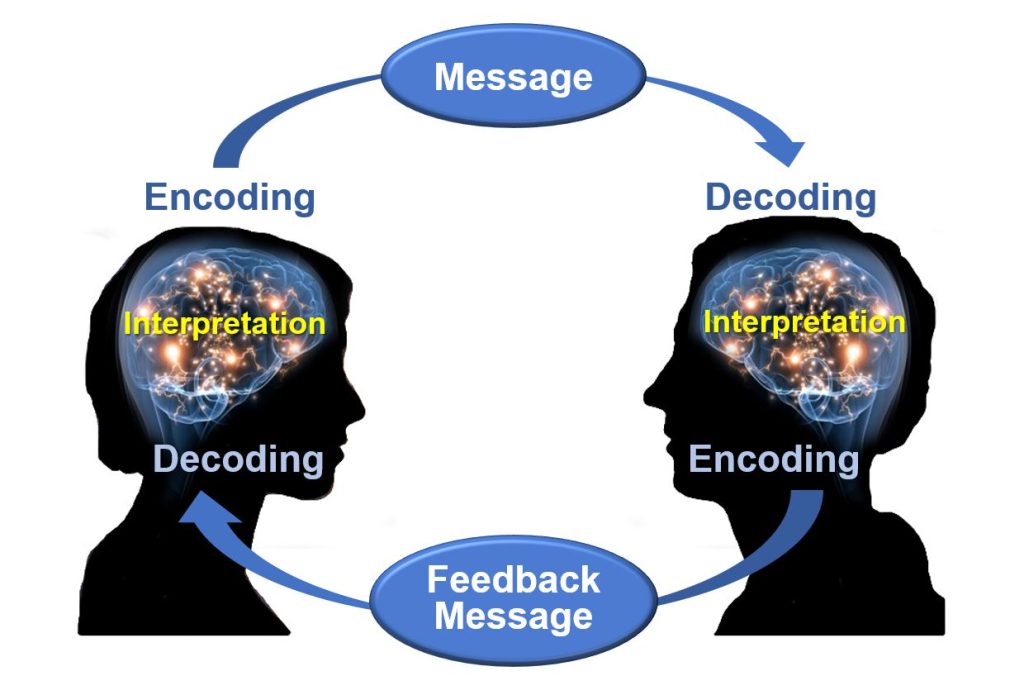3.1: Communication Styles
A Model of How Communication Works
It is no wonder that communication problems arise in our daily lives. When you have a thought or an impulse, how does get it from inside your brain or body out into the world? How do you package it so that it can successfully enter the mind of another person? How can you know if the message was received in the way it was intended?
Before identifying a communication problem or designing a solid solution, it can be helpful to understand what happens when we communicate. Consider this model:

Even professional scholars often experience their thinking as a messy, impulsive, unstructured experience. When you have a thought that you want to share, the first step you must take is to encode that idea into a message. This means that you must give your thoughts a shape that will make sense to other people. This involves thinking about your audience so that you can choose the most appropriate language.
Next, you must choose the best channel to share that message. What is the best way to get your message across? Text? Email? Letter? Simple conversation? Even “simple conversation,” however, is highly complex. Think of what happens when you choose to communicate through in-person speech. Your brain sends electrical impulses to your lungs, which push air past your vocal cords. Your brain must also send electrical impulses to vibrate your vocal cords to bend the air into a sound. You must then shape those sound waves further with your jaw, tongue, and lips.
Those sound waves move through the air till they reach the eardrum of the receiver. Their eardrum vibrates in a way that tickles the cochlear cilia in their inner ear, which sends a patterned electrical impulse into their brain. Their brain then decodes that impulse, or unpacks the idea in the message. Your reader or listener must try to figure out what you intended to say. This includes what you said and how you said it (ex. not only word choice, but also tone of voice, timing, and body language). Hopefully, this inspires thoughts or actions of their own and they will respond with feedback. The feedback they give will give you information about whether or not the message was received the way you intended.
Sound complex? No wonder communication needs to be seen as a form of problem-solving!
Table 3.1: Examples of Communication Channels
| Verbal | Written | Visual |
|---|---|---|
| In-person speech | Drawings, paintings | |
| Phone conversation | Text, instant message | Photos, graphic designs |
| Voice-over-internet protocol (VoIP) | Report, article, essay | Body language (e.g., eye contact, hand gestures) |
| Radio | Letter | Graphs |
| Podcast | Memo | Font types |
| Voicemail message | Blog | Semaphore |
| Intercom | Tweet | Architecture |
This model may seem to over-complicate something that you do thousands of times every day. Imagine this: what if you had a feeling of being thirsty and wanted to communicate that? You might say to your friend, “I’m thirsty.” The receiver of that message might respond by saying, “Me too. Let’s go fill up our water bottles.” From that response, you would know that your message was received and interpreted as you intended. The conversation could continue to cycle around in a back-and-forth conversation that exchanges ideas and makes coordinated action possible.
This example may seem excessive for describing such a simple conversation. The model becomes more useful when you’re trying to understand why a more complex message that was sent at school or work was not received in the way that you intended. By learning to recognize the different parts of the “communication machine,” you can better diagnose what’s going wrong when a message is not received in the way you expect.
An even better use of the model would be for you to ensure an effective communication experience in the first place. In professional situations, especially high-stakes scenarios, such as job interviews or client meetings, there is so much to gain through skilled communication.
Additional Readings & Resources
- Palmer, M. (2023, November 7). Types of Communication Styles And How to Identify Them. Southern New Hampshire University. https://www.snhu.edu/about-us/newsroom/liberal-arts/types-of-communication-styles
- Child Care Education Institute. (2021, September 7). How to Promote Effective Communication in Childcare. CCEI, A StraighterLine Company. https://www.cceionline.com/how-to-promote-effective-communication-in-childcare/
- ABC Life Literacy Canada. (2022, February 14). What is Non-Verbal Communication?
. YouTube. https://www.youtube.com/watch?v=HxDqYEl20hI
Exercises
 1. Without looking at the communication process model above, draw a picture that shows your own personal theory of how communication works. Label the diagram’s parts. Compare it to the model above and discuss the advantages and disadvantages of each.
1. Without looking at the communication process model above, draw a picture that shows your own personal theory of how communication works. Label the diagram’s parts. Compare it to the model above and discuss the advantages and disadvantages of each.
2. Table 1 above compiles only a partial list of channels for verbal, written, and visual channels. What other forms of communication could be added to the list?
References
Kisspng. (2018, March 17). Clip art – Two people talking. https://www.kisspng.com/png-clip-art-two-people-talking-569998/
Schramm, W. L. (1954). The Process and Effects of Mass Communication. University of Illinois Press.

